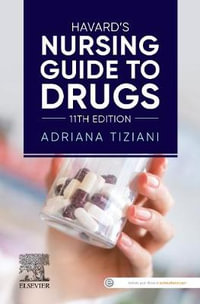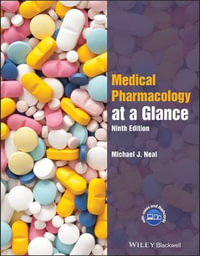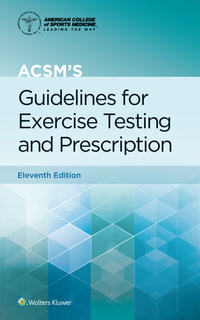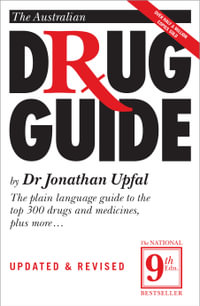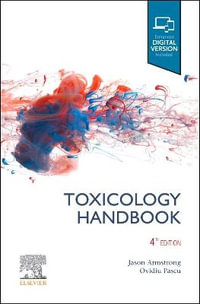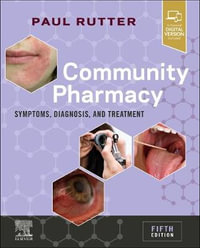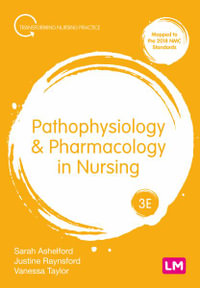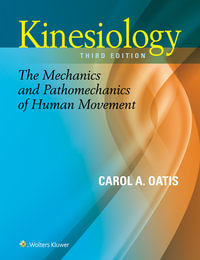
At a Glance
397 Pages
27.94 x 20.96 x 1.91
Hardcover
RRP $222.95
$168.75
24%OFF
or 4 interest-free payments of $42.19 with
orAims to ship in 5 to 10 business days
KEY FEATURES:
* One work that can be consulted for all aspects of anticancer drug development
* Concise reviews of research fields, combined with practical scientific detail, written by internationally respected experts
* A wealth of ideas on current and future molecular targets for drug design, including signal transduction, the cell division cycle, and programmed cell death
* Detailed descriptions of the sources of new anticancer drugs, including combinatorial chemistry, phage display, and natural products
* Discussion of how new drugs can be tested in preclinical systems, including the latest technology of robotic assay systems, cell culture, and experimental animal techniques
* Hundreds of references that allow the reader to access relevant scientific and medical literature
* Clear illustrations, some in color, that provide both understanding of the field and material for teaching
Industry Reviews
| Contributors | p. xi |
| Preface | p. xiii |
| A Brief History of Cancer Chemotherapy | |
| Summary | p. 1 |
| Introduction | p. 1 |
| Genotoxic (Cytotoxic) Therapy | p. 2 |
| Growth Control Pathways | p. 5 |
| Host-Tumor Interactions | p. 7 |
| Conclusions | p. 8 |
| References | p. 9 |
| Novel Targets in the Cell Cycle and Cell Cycle Checkpoints | |
| Summary | p. 13 |
| Introduction | p. 12 |
| Molecular Regulation of Cell Cycle Progression | p. 14 |
| Molecular Regulation of Cell Cycle Checkpoints | p. 15 |
| Rationale for Targeting Cyclin-Dependent Kinases and Cell Cycle Checkpoint Pathways | p. 17 |
| Agents and Strategies for Therapeutic Interference | p. 19 |
| Conclusions | p. 24 |
| References | p. 25 |
| Growth Factor and Signal Transduction Targets for Cancer Therapy | |
| Summary | p. 31 |
| Introduction | p. 31 |
| The ErbB Family of Receptor Tyrosine Kinases (RTKs) | p. 32 |
| The Ras-Raf-MEK-ERK Signaling Pathway | p. 34 |
| c-Src Kinase, Signal Transduction, Transformation, and Cancer | p. 37 |
| Akt | p. 38 |
| Nuclear Hormone Receptors as Targets for Cancer Therapy | p. 40 |
| Implications for Drug Discovery and Development | p. 43 |
| References | p. 44 |
| Cell Death Pathways as Targets for Anticancer Drugs | |
| Summary | p. 55 |
| Introduction | p. 56 |
| Two Main Pathways for Drug-Induced Apoptosis | p. 56 |
| Modulation of Drug-Induced Cell Death by Bcl-2 and Related Proteins | p. 58 |
| The Central Role of Caspases in Drug-Induced Apoptosis | p. 61 |
| Synergy between Death Receptors and Cytotoxic Drugs | p. 64 |
| The Rel/NF-kB/lkB Proteins | p. 69 |
| Conclusion | p. 70 |
| References | p. 70 |
| Drug Resistance Pathways as Targets | |
| Summary | p. 77 |
| Introduction | p. 77 |
| Targeting Drug Transport | p. 78 |
| Targeting Cellular Stress Responses | p. 81 |
| Targeting DNA Repair Systems | p. 85 |
| Conclusions | p. 86 |
| References | p. 86 |
| Role of Matrix Metalloproteinases and Plasminogen Activators in Cancer Invasion and Metastasis: Therapeutic Strategies | |
| Summary | p. 91 |
| Introduction | p. 92 |
| The Extracellular Matrix | p. 92 |
| Cancer Invasion and Metastasis | p. 92 |
| Cell Adhesion in Cancer | p. 94 |
| Cancer Cell Motility | p. 95 |
| Inflammatory Response to Cancer | p. 95 |
| Proteolytic Enzymes Implicated in Cancer Invasion | p. 96 |
| MMPIs as Novel Anticancer Agents | p. 104 |
| Sheddases | p. 111 |
| The uPA System: Proteolytic Control of MMP Activation | p. 111 |
| References | p. 116 |
| Tumor Vasculature as a Target | |
| Summary | p. 123 |
| Introduction | p. 123 |
| How to Inhibit Tumor Angiogenesis | p. 127 |
| Concluding Remarks | p. 131 |
| References | p. 131 |
| Gene-Directed Enzyme Prodrug Therapy | |
| Summary | p. 137 |
| Introduction | p. 137 |
| Background | p. 138 |
| Enzyme-Prodrug Systems | p. 138 |
| Tailored Prodrugs for GDEPT | p. 140 |
| The Activation Process | p. 148 |
| Augmenting the Effect | p. 149 |
| Exploiting the Bystander Effect and Acquired Immunity | p. 150 |
| Conclusions | p. 151 |
| References | p. 152 |
| Tumor Antigens as Targets for Anticancer Drug Development | |
| Summary | p. 157 |
| Introduction | p. 157 |
| Antigen Targets for Cancer Vaccines | p. 158 |
| Tumor Antigens as Targets for Antibody-Based Therapeutics | p. 164 |
| References | p. 168 |
| Structure-Based Drug Design and Its Contributions to Cancer Chemotherapy | |
| Summary | p. 171 |
| Introduction | p. 171 |
| Antimetabolites | p. 173 |
| Protease Inhibitors | p. 176 |
| Protein Kinase Inhibitors | p. 179 |
| Other Targets | p. 181 |
| Novel Methods in Structure-Based Drug Design | p. 182 |
| Conclusions and Current Questions | p. 183 |
| References | p. 183 |
| The Contribution of Synthetic Organic Chemistry to Anticancer Drug Development | |
| Summary | p. 187 |
| Introduction | p. 188 |
| Early Rationality | p. 188 |
| The Random Screening Era: Directly from Screen to Clinic | p. 188 |
| Organic Synthesis Catches Up: Development of National Product Leads | p. 189 |
| Development of Synthetic Compounds: Structure-Activity Relationships | p. 190 |
| Immunotoxins: Synthetic Organic Chemistry Applied to Large Molecules | p. 191 |
| Organic Synthesis in Rational Design: Tumor-Activated Prodrugs of Cytokines | p. 191 |
| Early Genomics: Inhibitors of Transmembrane Tyrosine Kinases | p. 194 |
| The Genomics/Proteomics Era: Combinatorial Chemistry | p. 195 |
| Conclusion | p. 198 |
| References | p. 199 |
| Biosynthetic Products for Anticancer Drug Design and Treatment: The Bryostatins | |
| Summary | p. 203 |
| Introduction | p. 203 |
| Background to the Bryostatins | p. 204 |
| Comprehensive Review of Bryostatin Scientific and Medical Reports | p. 205 |
| References | p. 220 |
| DNA-Encoded Peptide Libraries and Drug Discovery | |
| Summary | p. 237 |
| Introduction | p. 237 |
| Methods for DNA-Encoded Peptide Display | p. 237 |
| Applications for DNA-Encoded Peptide Libraries | p. 241 |
| Conclusions | p. 246 |
| References | p. 246 |
| Mechanism-Based High-Throughput Screening for Novel Anticancer Drug Discovery | |
| Summary | p. 249 |
| Importance of Mechanism-Based Targets in Postgenomic Drug Discovery | p. 250 |
| High-Throughput Screening | p. 251 |
| Assay Technologies | p. 255 |
| Assay Performance and Downstream Evaluation of Bits | p. 259 |
| Compounds for HTS | p. 260 |
| Examples of Compounds Identified Through Screening Approaches | p. 261 |
| Future HTS Developments | p. 263 |
| Concluding Remarks | p. 264 |
| References | p. 264 |
| Tumor Cell Cultures in Drug Development | |
| Summary | p. 269 |
| Introduction | p. 269 |
| Growth Inhibition Assays | p. 270 |
| Clongenic Assays | p. 274 |
| Three-Dimensional Cell Cultures: Modeling Extravascular Drug Transport | p. 275 |
| Modeling of in Vivo Activity by in Vitro Assays | p. 278 |
| Perspective | p. 280 |
| References | p. 280 |
| Screening Using Animal Systems | |
| Summary | p. 285 |
| Introduction | p. 285 |
| Choice of in Vivo Systems for Large-Scale Drug Development | p. 286 |
| Combined in Vitro/in Vivo Testing Procedure Using Human Tumor Xenografts--The Freiburg Experience | p. 289 |
| Use of Transgenic Animals in the Search for New Drugs | p. 293 |
| Screening for Angiogenesis Inhibitors | p. 295 |
| References | p. 297 |
| Relevance of Preclinical Pharmacology and Toxicology to Phase I Trial Extrapolation Techniques: Relevance of Animal Toxicology | |
| Summary | p. 301 |
| Introduction | p. 302 |
| Historical Perspective | p. 302 |
| Special Toxicity Evaluations | p. 303 |
| Recent Examples of Drug Development at NCI | p. 303 |
| Predictability of Nonclinical Animal Data | p. 320 |
| Conclusions | p. 323 |
| References | p. 323 |
| Clinical Trial Design: Incorporation of Pharmacokinetic, Pharmacodynamic, and Pharmacogenetic Principles | |
| Summary | p. 329 |
| Introduction | p. 330 |
| Rationale for Chemotherapy Optimization | p. 330 |
| Pharmacokinetic-Pharmacodynamic Relationships | p. 332 |
| Pharmacogenetics | p. 335 |
| Strategies to Improve Therapeutic Index | p. 340 |
| Conclusion and Perspectives | p. 347 |
| References | p. 348 |
| Tumor Imaging Applications in the Testing of New Drugs | |
| Summary | p. 353 |
| Introduction | p. 353 |
| Positron Emission Tomography | p. 354 |
| PET in New Drug Evaluation | p. 355 |
| Conclusions | p. 365 |
| References | p. 365 |
| Mechanistic Approaches to Phase I Clinical Trials | |
| Summary | p. 371 |
| Introduction | p. 371 |
| Mechanism-Based Studies of Established Anticancer Agents to Assess Target Inhibition | p. 373 |
| Mechanistic Trial Perspectives on Anticancer Agents with Novel Mechanisms | p. 373 |
| Potential of PET Scanning in the Assessment of Pharmacodynamic End Points | p. 381 |
| Conclusion | p. 381 |
| References | p. 381 |
| Index | p. 385 |
| Table of Contents provided by Syndetics. All Rights Reserved. |
ISBN: 9780120726516
ISBN-10: 0120726513
Published: 15th October 2001
Format: Hardcover
Language: English
Number of Pages: 397
Audience: Professional and Scholarly
Publisher: Academic Press
Country of Publication: US
Dimensions (cm): 27.94 x 20.96 x 1.91
Weight (kg): 1.18
Shipping
| Standard Shipping | Express Shipping | |
|---|---|---|
| Metro postcodes: | $9.99 | $14.95 |
| Regional postcodes: | $9.99 | $14.95 |
| Rural postcodes: | $9.99 | $14.95 |
How to return your order
At Booktopia, we offer hassle-free returns in accordance with our returns policy. If you wish to return an item, please get in touch with Booktopia Customer Care.
Additional postage charges may be applicable.
Defective items
If there is a problem with any of the items received for your order then the Booktopia Customer Care team is ready to assist you.
For more info please visit our Help Centre.
You Can Find This Book In

Australia and New Zealand McKenna's Drug Handbook for Nursing and Midwifery
Australia and New Zealand 9th edition
Paperback
RRP $87.95
$74.75
OFF
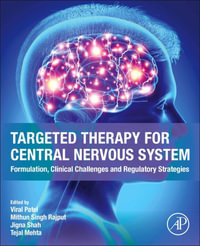
Targeted Therapy for Central Nervous System
Formulation, Clinical Challenges and Regulatory Strategies
Paperback
RRP $352.95
$266.50
OFF

A Clinician's Guide to Treating OCD
The Most Effective CBT Approaches for Obsessive-Compulsive Disorder
Paperback
RRP $94.95
$53.25
OFF
This product is categorised by
- Non-FictionMedicineOther Branches of MedicinePharmacology
- Non-FictionMedicineClinical & Internal MedicineDiseases & DisordersOncologyChemotherapy
- Non-FictionMedicineMedicine in GeneralMedical Equipment & TechniquesMedical Research
- Non-FictionMedicineMedicine in GeneralMedical Equipment & TechniquesMedical Laboratory Testing & Techniques
- Non-FictionMedicineNursing & Ancillary ServicesPharmacy & Dispensing
- Non-FictionScienceBiology, Life SciencesMolecular Biology
